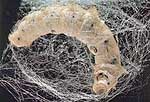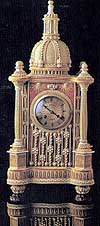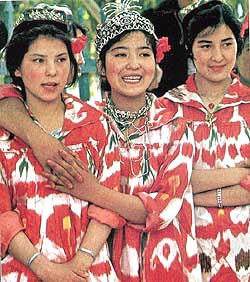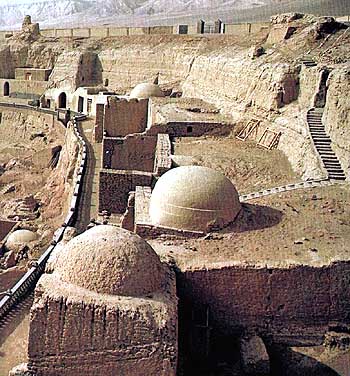by Chalerm Raksanti
According to a popular legend, the Chinese dominance of
‘sericulture’ (raising silkworms) was weakened when Emperor Justinian,
in the 16th century, dispatched several monks on an
espionage trip to bring back silkworm eggs from China. They brought the
eggs back to Constantinople in hollow canes. These were sort of the
“Adam and Eve” silkworms of the West, where fine silks were produced
in palace workshops.
 A
modest little silkworm spinning his cocoon.
A
modest little silkworm spinning his cocoon.
The Silk Road was actually a perilous network of
routes. It was hazardous to monks and pilgrims carrying Buddhist teachings
between India and China, and even more treacherous to traders who intended
to exchange gold, horses, jade and glass for silk. The road started from
what is now X’ian in Shanghai Province, traversed a barren crust of
mountains and desert across Central Asia to Antioch and Trye; the last lap
to Europe and Egypt. This sector was traveled by water to other
Mediterranean ports.
Few made the entire trip. Caravan loads were passed
from trader to trader at each oasis and stronghold. Prices went up with
each exchange. Neither civilization, West or East, knew much about the
other beyond the edge of the route. Yet the patterns of silks were
flavored by all the different cultures along the Road. Caravans once
trudged past the Buddhist retreat of Bezeklilk, and on through the Gobi
Desert. Bezeklilk lies on the northern fork of the 4,000 mile Silk Road.
 A
Renaissance French royal palace clock made from silk knots and braiding.
A
Renaissance French royal palace clock made from silk knots and braiding.
In the Middle Ages silk was woven into every conquest
and trade. The rush of Islam carried silk from the Middle East across
North Africa to the Iberian Peninsula. The Christian Crusaders gave relics
wrapped in fabulous silks to the Church. Venetians not only traded
heavily, but also imported silk growers and weavers to help pioneer their
own silk industry. By the 13th century the Italian
silk industry was amassing the riches that helped finance the Renaissance.
Some of the most beautiful and ancient Italian silk vestments are still
used in churches in small Italian towns like the Basilica di Santa Maria
Assunta in Gandino.
By the 14th century King Louis XI
took drastic steps to curb the tremendous outflow of money From France to
Italy by boosting French silks with royal orders to weavers in Tours. Lyon
began to flourish in the 16th century with
assistance from King Francis the First. The French enticed Italian
craftsmen with promises of more freedom in their work if they would work
in Lyon. In the late 18th century France’s city of
Lyon had 18,000 silk looms in operation.
 A
young Indian girl uses the “thigh reeling” method of spinning silk
thread over her leg.
A
young Indian girl uses the “thigh reeling” method of spinning silk
thread over her leg.
Across the Atlantic, sericulture got its first push in
1609 when James I of England encouraged the production of silk (and
discouraged the growing of tobacco) so he could fill English looms.
Interwoven in the loom of humanity, the commerce of
silk engages the rich, the poor, the old and the young. Ten and twelve
year old girls in Nuapatna, India, engage in the traditional method of
silk spinning which is called “thigh-reeling”. Drawing the fibers from
pierced cocoons, the girls twist the strands across the leg for about one
dollar a day. A young boy will begin his apprenticeship in the silk trade
by performing such tasks as delivering Jacquard punch cards, which direct
a mechanical loom’s movements, to the weavers’ shops.
 Uygur
women attend a cocoon harvest festival in Hotan, China where they show off
their own silk patterns woven during the winter months.
Uygur
women attend a cocoon harvest festival in Hotan, China where they show off
their own silk patterns woven during the winter months.
At China’s Hang Zhou Silk Factory, the yarn is
reeled, graded, color coded by a temporary dye, twisted, washed and wound
into skeins. Some 35 countries produce raw silk. But compared to the
manufacture, which is measured in millions of tons per year, world
production of this labor intensive (and consequently expensive) cloth is
slight. Silkworm growers in Japan raise their own brood on an artificial
diet. The silkworm has an insatiable appetite. All are true little eating
machines!
There is something miraculous in silk. Women have
always believed that there is no substitute for real silk for luxurious
and lustrous dresses. This queen of textiles changed the course of history
in many parts of the globe and left footprints in the sands of time. All
of this from the completely unassuming little silkworm.

The
restored Buddhist retreat of Bezeklik, along the 4,000 mile long Silk
Road.

 A
modest little silkworm spinning his cocoon.
A
modest little silkworm spinning his cocoon. A
Renaissance French royal palace clock made from silk knots and braiding.
A
Renaissance French royal palace clock made from silk knots and braiding. A
young Indian girl uses the “thigh reeling” method of spinning silk
thread over her leg.
A
young Indian girl uses the “thigh reeling” method of spinning silk
thread over her leg. Uygur
women attend a cocoon harvest festival in Hotan, China where they show off
their own silk patterns woven during the winter months.
Uygur
women attend a cocoon harvest festival in Hotan, China where they show off
their own silk patterns woven during the winter months.
